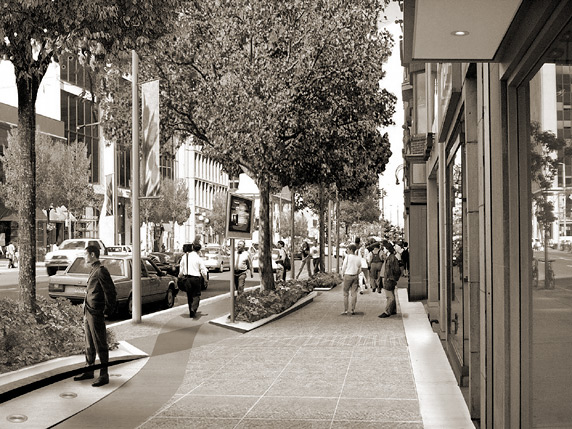|
An artists’ rendering of the Bloor Street makeover. We are hoping that the signage in the sidewalk island is not a new form of ad creep on our streets. |
: : : : : : : Toronto’s premier shopping street is getting a facelift. The Bloor-Yorkville Business Improvement Association is spearheading the reinvention of Bloor Street between Avenue Road and Church Street as a pedestrian destination for consumers of luxury. Brown and Storey Architects claim their design will create one of the “most daring and exciting streets in the world.” Yet this stretch of Bloor may end up nothing more than a publicly subsidized shopping mall. Streetscaping to increase pedestrian comfort and promote business along a city street is a common strategy. On Bloor, a lane of parking will be reclaimed to allow the widening of the sidewalk and the inclusion of trees, flowerbeds, textured pavements, and public art. The design proposes a sidewalk with two sections joined together by a sinuous path of textured pavement. The area closest to the stores is left free for consumers to better view window displays. In the rest of the path flowerbeds alternate between the edge of the road and the middle of the sidewalk, imposing a zigzagging obstacle course for the walking commuter who wants to avoid window shoppers. Unable to take the most direct route, a straight line, the commuter’s path becomes reminiscent of the erratic path of an impulse shopper in a mall, confronted by another window display at each turn between flowerbeds. Without the parked cars, planting strips, or street furniture which usually buffer friction between pedestrians and vehicles, these walkers will find themselves passing within inches of speeding cars each time the outer portion of the pedestrian way curves outside the plantings. Bloor Street’s new party clothes are designed to physically unify the experience afforded by the street, complementing current promotional coordination by the BIA. This enhanced and sanitized visual harmony likens this stretch of Bloor Street to the interior of suburban shopping complexes. Many standard amenities of an urban street are conspicuously absent (details that the designers/managers claim will be dealt with in later phases). There is no allowance for public areas or benches where one might sit, rest or congregate, no public water fountains or bicycle parking areas. Is this a sign of a fear that the “wrong” people might be tempted to use these public facilities, jeopardizing the street’s imitation of the private and controlled environments of shopping malls? Or is every bench a lost opportunity for another paying customer at one of the street’s indoor cafes? Another issue that has not yet been solved is garbage cans. The Bloor Street transformation is confronted with the city's exclusive arrangement with OMG/Eucan to supply garbage cans for the city. The designers believe that the garbage cans as they are usually installed will cheapen the overall experience, covered with advertisements that do not reflect targeted neighbourhood activities and patrons. The BIA is proposing strict design guidelines that conflict with current city policy, in an attempt to control their installation. While most people believe the Bloor Street transformation is an example of private philanthropy, the majority of the project's funds are to come from all three levels of government. The City of Toronto has pledged ten million dollars, matching the total of funds raised privately. Even with the questionable promise that the cash-strapped city’s ten million dollar investment will be recovered as tax revenue, one is left wondering how subsidizing the city’s wealthiest shopping area supersedes other priorities, and whether the city should not insist on a design that furthers broader city objectives and benefits all the street’s users, rather than just wealthy shoppers. But pedestrians who look but don’t buy aren’t good for business, and this street is made for shopping. |
|
spacing.ca || contact || subscribe || in this issue || stores (c) 2005 Spacing Publishing |

